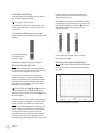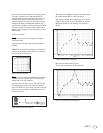
9
CSW-10
At this point, you may simply enter the data you just
measured into the R.A.B.O.S. calculator, found on the
Infinity Web site at www.infinitysystems.com.After
entering the data, this R.A.B.O.S.wizard will return the correct
settings for all three R.A.B.O.S. controls:
ª
,
‚
and
⁄
. Skip
to page 14 and adjust these controls as described, and finish
the R.A.B.O.S. setup. If you would like to manually calculate the
R.A.B.O.S. settings, simply continue following the instructions
from this point.
What Does a Parametric Equalizer Do?
The R.A.B.O.S.system uses one band of parametric equalization
for response correction. Parametric equalizers are the most
versatile class of filters.The effect an equalizer will have on the
signal is dependent on three parameters.
Frequency:The equalizer will have maximum effect at one
frequency,usually described as the center frequency.
Level: This refers to the amount of cut (in dBs) the equalizer
is set for.
Bandwidth: Defines the range of frequencies over which the
equalizer will have an effect. On the CSW-10, this adjustment is
abbreviated as “Width.”
Only parametric equalizers allow independent adjustment of all
three parameters.
These will be explained more fully in the sections that follow.
Completing the Measurement Template
Along the bottom of the Measurement Template are three fields
where you will enter the equalizer settings needed to complete
system optimization.
These instructions are based on the example in Figure 11. Use
this tutorial to become familiar with the process. Strategies for
several other test results will be presented later.After you have
completed these three entry fields, you will be ready to perform
the adjustments, completing R.A.B.O.S. optimization.
Frequency
The frequency of the R.A.B.O.S. equalizer may be adjusted to
any one of nineteen frequencies from 20Hz to 80Hz.This defines
where you are going to apply equalization.
Width
The frequency range of the R.A.B.O.S. equalizer may be set from
5% to 50% of an octave in 21 steps.This setting defines how
much of the CSW-10’s output will be equalized.
Width is expressed as a percentage of an octave. For example,a
width setting of 25% means the equalizer will affect a frequency
band of 1/4 of an octave; 1/8 of an octave above and 1/8 of an
octave below the center frequency.
The octave is a logarithmic expression. From any point
in the spectrum, one octave above or below that point is always
double or half the frequency.Therefore, one octave above 100Hz
would be 200Hz. One octave below 100Hz is 50Hz.
In the section that follows, we will discuss the use of the
Width Selector.
Figure 11.Effect of adjustable width
STOP


















